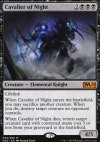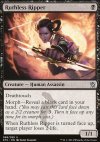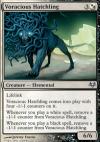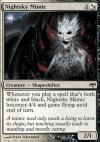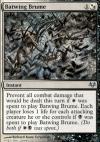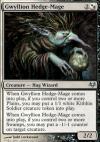|

MV anecdotes
| 960 anecdotes trouvées |   |
Les cartes Strider, Ranger of the North, Aragorn, Company Leader et Aragorn, the Uniter forment un cycle vertical (cartes d'une même couleur mais avec une rareté différente) de l'édition The Lord of the Rings: Tales of Middle-earth. Chacune représente Aragorn et son évolution au fil de l'histoire.
Les cartes Chandra, Novice Pyromancer, Chandra, Acolyte of Flame et Chandra, Awakened Inferno forment un cycle vertical (cartes d'une même couleur mais avec une rareté différente) de l'édition Core Set 2020.
Source (Plane(swalker) and Simple - "What if the set didn't have one Chandra, but three? Core Set 2020 could have an uncommon Chandra, a rare Chandra, and a mythic rare Chandra.")
Source (Plane(swalker) and Simple - "What if the set didn't have one Chandra, but three? Core Set 2020 could have an uncommon Chandra, a rare Chandra, and a mythic rare Chandra.")
Les cinq cartes Cavalier of Dawn, Cavalier of Gales, Cavalier of Night, Cavalier of Flame et Cavalier of Thorns, de l'édition Core Set 2020, forment un cycle appelé "Cavalier".
Source (Mythic Rare Cycles - Cavaliers)
Source (Mythic Rare Cycles - Cavaliers)
Les cinq cartes Abzan Banner, Jeskai Banner, Sultai Banner, Mardu Banner et Temur Banner, de l'édition Khans of Tarkir et illustrées par Daniel Ljunggren, forment un cycle appelé "Banner". De plus leurs textes d'ambiance se font écho.
Les cinq cartes Watcher of the Roost, Dragon's Eye Savants, Ruthless Ripper, Horde Ambusher et Temur Charger, de l'édition Khans of Tarkir, forment un cycle.
Les dix cartes Unyielding Krumar, Archers' Parapet, Bloodfire Mentor, Leaping Master, Kheru Dreadmaw, Smoke Teller, Firehoof Cavalry, Mardu Hateblade, Embodiment of Spring et Scaldkin, de l'édition Khans of Tarkir, forment un cycle.
Les cinq cartes Light from Within, Sanity Grinding, Umbra Stalker, Fiery Bombardment et Primalcrux, de l'édition Eventide, forment un cycle.
Les cinq cartes Antler Skulkin, Shell Skulkin, Fang Skulkin, Jawbone Skulkin et Hoof Skulkin, de l'édition Eventide, forment un cycle appelé "Skulkin".
Les cinq cartes Voracious Hatchling, Shrewd Hatchling, Noxious Hatchling, Belligerent Hatchling et Sturdy Hatchling, de l'édition Eventide, forment un cycle appelé "Hatchling".
Les cinq cartes Nightsky Mimic, Riverfall Mimic, Woodlurker Mimic, Battlegate Mimic et Shorecrasher Mimic, de l'édition Eventide et illustrées par Franz Vohwinkel, forment un cycle appelé "Mimic".
Les cinq cartes Ballynock Trapper, Merrow Levitator, Merrow Bonegnawer, Cinder Pyromancer et Nettle Sentinel, de l'édition Eventide, forment un cycle.
Les cinq cartes Suture Spirit, Talonrend, Creakwood Ghoul, Duergar Cave-Guard et Swirling Spriggan, de l'édition Eventide, forment un cycle.
Les cinq cartes Batwing Brume, Unnerving Assault, Cankerous Thirst, Moonhold et Invert the Skies, de l'édition Eventide, forment un cycle.
Les cinq cartes Gwyllion Hedge-Mage, Noggle Hedge-Mage, Hag Hedge-Mage, Duergar Hedge-Mage et Selkie Hedge-Mage, de l'édition Eventide, forment un cycle appelé "Hedge-Mage".
Les cinq cartes Steel of the Godhead, Helm of the Ghastlord, Fists of the Demigod, Runes of the Deus et Shield of the Oversoul, de l'édition Shadowmoor, ainsi que les cinq cartes Edge of the Divinity, Clout of the Dominus, Gift of the Deity, Scourge of the Nobilis et Favor of the Overbeing, de l'édition Eventide, forment un cycle d'auras bicolores, avec un coût de mana comprenant un mana hybride, et dont les effets durent tant que la créature enchantée est de l'une et/ou l'autre des couleurs de la paire de couleurs.
Ce cycle d'auras fait référence à celui des Esprits et Avatars de ce Plan (voir cette anecdote) de par leur nom et leurs couleurs respectives.
Source 1 ( #24) Fists of the Demigod ) - Source 2 ( #71) Runes of the Deus )
Ce cycle d'auras fait référence à celui des Esprits et Avatars de ce Plan (voir cette anecdote) de par leur nom et leurs couleurs respectives.
Source 1 ( #24) Fists of the Demigod ) - Source 2 ( #71) Runes of the Deus )
Les cinq cartes Godhead of Awe, Ghastlord of Fugue, Demigod of Revenge, Deus of Calamity et Oversoul of Dusk, de l'édition Shadowmoor, ainsi que les cinq cartes Divinity of Pride, Dominus of Fealty, Deity of Scars, Nobilis of War et Overbeing of Myth, de l'édition Eventide, forment un cycle de créatures bicolores Esprits et Avatars, avec un coût de cinq manas hybrides.
Source ("Let me start by explaining that this is white-blue's "demigod"—that is, this is part of a five hybrid mana cost creature cycle at rare. The first preview card Demigod of Revenge is also in the cycle. Yes, that means there's three more for you to see.")
Source ("Let me start by explaining that this is white-blue's "demigod"—that is, this is part of a five hybrid mana cost creature cycle at rare. The first preview card Demigod of Revenge is also in the cycle. Yes, that means there's three more for you to see.")
Les cinq cartes Thistledown Liege, Glen Elendra Liege, Ashenmoor Liege, Boartusk Liege et Wilt-Leaf Liege, de l'édition Shadowmoor, ainsi que les cinq cartes Deathbringer Liege, Mindwrack Liege, Creakwood Liege, Balefire Liege et Murkfiend Liege, de l'édition Eventide, forment un cycle appelé "Liege" de créatures bicolores de type Chevalier, respectivement Horreur, avec un coût de mana comprenant trois manas hybrides, et renforçant les créatures que vous contrôlez de chacune de leurs couleurs.
Source ( #3) Ashenmoor Liege )
Source ( #3) Ashenmoor Liege )
Les cinq cartes Armored Ascension, Flow of Ideas, Corrupt, Jaws of Stone et Howl of the Night Pack, de l'édition Shadowmoor, forment un cycle de sorts vérifiant le nombre de terrains de base que vous contrôlez associés à la couleur du sort pour renforcer son effet.
Les cinq cartes Spectral Procession, Advice from the Fae, Beseech the Queen, Flame Javelin et Tower Above, de l'édition Shadowmoor, forment un cycle.
Avec Reaper King, ce sont les premières cartes avec un coût de mana composé de manas hybrides monochromes (une couleur unique et deux manas génériques).
Source 1 (Twobrid Mana - "Twobrid mana was first introduced in Shadowmoor on six cards. It's only ever appeared on those six cards, so it's something that the enfranchised audience is familiar with, but it's a vein of design space we've barely touched.") - Source 2 (Shadowmoor Block - "Six of the cards in the set introduced a new type of hybrid mana, what we in R&D call "twobrid." [...]")
Avec Reaper King, ce sont les premières cartes avec un coût de mana composé de manas hybrides monochromes (une couleur unique et deux manas génériques).
Source 1 (Twobrid Mana - "Twobrid mana was first introduced in Shadowmoor on six cards. It's only ever appeared on those six cards, so it's something that the enfranchised audience is familiar with, but it's a vein of design space we've barely touched.") - Source 2 (Shadowmoor Block - "Six of the cards in the set introduced a new type of hybrid mana, what we in R&D call "twobrid." [...]")
Les cinq cartes Resplendent Mentor, Deepchannel Mentor, Corrosive Mentor, Bloodmark Mentor et Roughshod Mentor, de l'édition Shadowmoor, forment un cycle appelé "Mentor" de créatures renforçant les créatures que vous contrôlez de leur couleur.
Les cinq cartes Mistmeadow Witch, Inkfathom Witch, Spiteflame Witch, Tattermunge Witch et Seedcradle Witch, de l'édition Shadowmoor, forment un cycle appelé "Witch".
Les cinq cartes Master Apothecary, Patron Wizard, Zombie Trailblazer, Dwarven Bloodboiler et Seton, Krosan Protector forment un cycle.
Les dix cartes Cloudblazer, Contraband Kingpin, Unlicensed Disintegration, Voltaic Brawler, Engineered Might, Restoration Gearsmith, Whirler Virtuoso, Hazardous Conditions, Veteran Motorist et Empyreal Voyager, de l'édition Kaladesh, forment un cycle de sorts bicolores peu communs soutenant chacun un archétype de formats limités.
Source ("Draft, as an example, had a big influence on the uncommon gold cards that model Draft archetypes")
Source ("Draft, as an example, had a big influence on the uncommon gold cards that model Draft archetypes")
Les cinq cartes Bastion Mastodon, Dukhara Peafowl, Prakhata Pillar-Bug, Weldfast Monitor et Narnam Cobra, de l'édition Kaladesh, forment un cycle.
| 960 anecdotes trouvées |   |






 Spider-Man / Omenpaths
Spider-Man / Omenpaths Edge of Eternities
Edge of Eternities Final Fantasy
Final Fantasy Tarkir: Dragonstorm
Tarkir: Dragonstorm Aetherdrift
Aetherdrift Foundations
Foundations Duskmourn
Duskmourn







